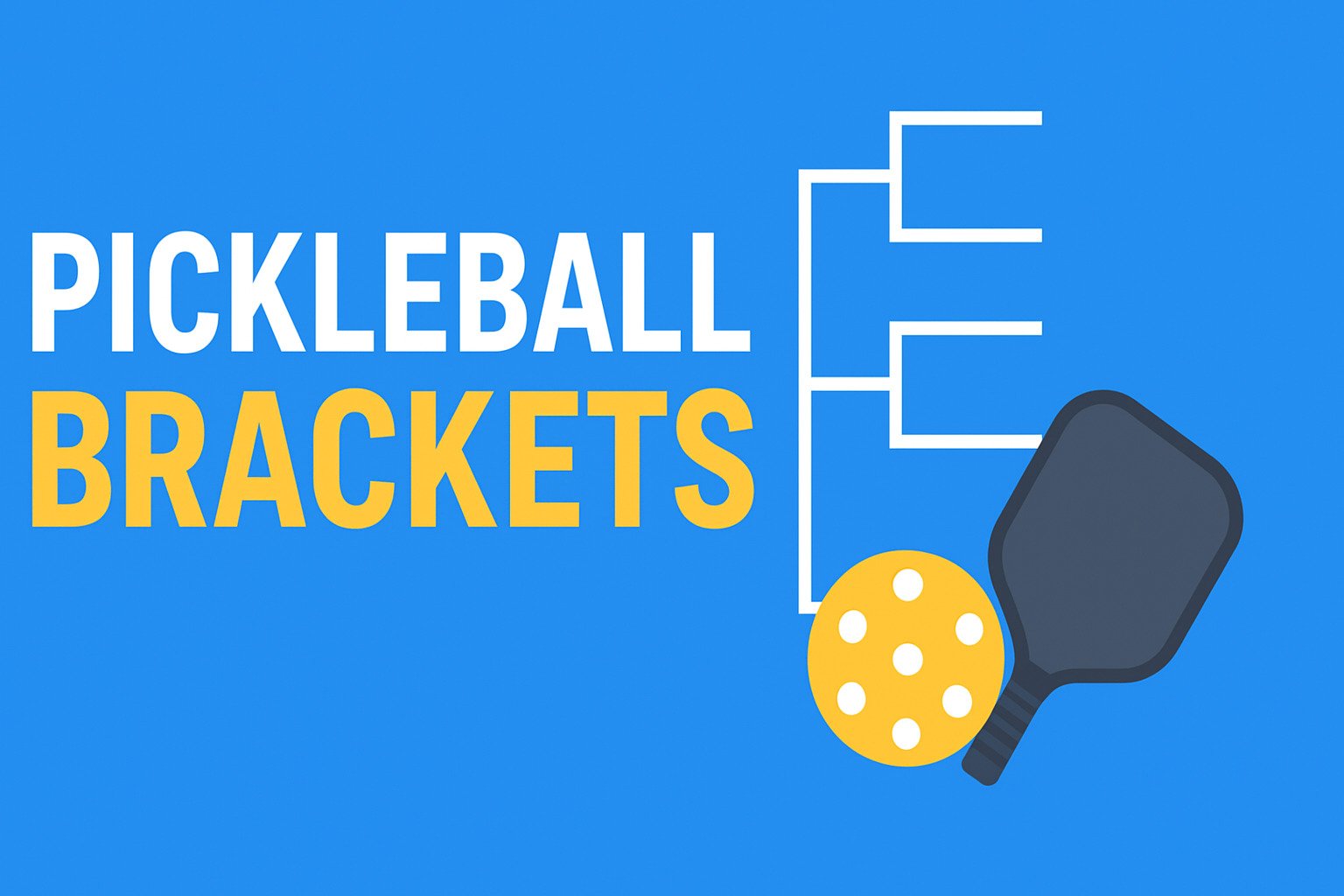
Pickleball has quickly become one of the fastest-growing sports worldwide, and with its growth, pickleball tournaments are happening everywhere—from local clubs to national championships. At the heart of every tournament lies a crucial element: the pickleball bracket system.
Whether you’re a player gearing up for competition or an organizer planning an event, understanding pickleball brackets is essential for fair play, smooth scheduling, and exciting matchups.
In this complete guide, we explain what pickleball brackets are, types of brackets, how seeding works, point systems, and how to create pickleball tournament brackets like a pro.
What Are Pickleball Brackets?
A pickleball bracket is a structured tournament layout that determines who plays whom, how players advance, and how final rankings are decided. Brackets prevent bias and ensure an organized path from the first match to finals.
Brackets are used for:
- Singles tournaments
- Doubles tournaments
- Mixed doubles
- Round-robin club leagues
- Recreational competitions
Key Benefits of Using Pickleball Brackets
| Benefits | Why It Matters |
|---|---|
| Fair competition | No favoritism—advancement depends purely on performance |
| Smooth scheduling | Easy to manage multiple matches and court time |
| Competitive excitement | Every stage builds toward semifinals and finals |
| Player motivation | Clear goals and ranking system keep players engaged |
| Accurate ranking | Determines exact standings for all players/teams |
Common Types of Pickleball Tournament Brackets
Pickleball tournaments can feature various types of brackets, depending on the format, number of participants, and competitive level. Here are the most common types of pickleball tournament brackets:
1. Single Elimination
- How it works: Players or teams are eliminated after losing one match. Winners advance to the next round until a champion is determined.
- Pros: Quick and straightforward; ideal for time-constrained events.
- Cons: Players are out after one loss, which can be disappointing for participants.
2. Double Elimination
- How it works: Players or teams must lose twice to be eliminated. After a first loss, they move to the “loser’s bracket” for a chance to fight their way back to the finals.
- Pros: Offers a second chance, making it more forgiving.
- Cons: Takes longer to complete and requires more matches.
3. Round Robin
- How it works: Each player or team competes against every other participant in their group. Winners are determined based on overall performance (e.g., most wins or points).
- Pros: Guarantees multiple matches for all participants; great for smaller groups.
- Cons: Can be time-consuming, especially with a large number of players.
4. Pool Play with Playoffs
- How it works: Players or teams are divided into pools (smaller groups) for round-robin play. Top performers from each pool advance to a single or double-elimination playoff bracket.
- Pros: Combines the benefits of round-robin and elimination formats; ensures everyone gets multiple matches.
- Cons: Requires careful scheduling and can be complex to organize.
5. Compass Draw
- How it works: Players or teams are guaranteed multiple matches regardless of whether they win or lose. After each round, winners and losers are placed into different brackets (e.g., East, West, North, South).
- Pros: Ensures everyone plays several matches; good for balancing competition levels.
- Cons: Can be confusing for participants unfamiliar with the format.
6. Ladder Bracket
- How it works: Players or teams are ranked on a “ladder” and compete to move up or defend their position. Matches are often scheduled based on rankings.
- Pros: Encourages competitive play and allows for ongoing adjustments.
- Cons: Works best for leagues or ongoing tournaments rather than single-day events.
7. Team-Based Brackets
- How it works: Teams of players compete in a series of matches, often including singles, doubles, and mixed doubles. The team with the most overall wins is declared the champion.
- Pros: Promotes camaraderie and teamwork.
- Cons: Requires more coordination and planning.
8. King/Queen of the Court
- How it works: Players rotate courts based on wins and losses, with the goal of reaching or staying on the “king/queen” court.
- Pros: Fun and fast-paced; great for social or casual tournaments.
- Cons: Less structured and not ideal for highly competitive events.
Each format has its own advantages and is suited to different types of tournaments, from casual local events to high-stakes championships. Organizers often choose based on the number of participants, time constraints, and the level of competition.
How Pickleball Seeding Works

Seeding in pickleball tournaments is the process of ranking players or teams before the tournament begins to ensure a fair and balanced competition. The goal is to prevent the strongest players or teams from facing each other in the early rounds, allowing for a more competitive and exciting progression through the tournament. Here’s how pickleball seeding typically works:
1. Determining Seeds
Seeding is based on various factors, depending on the tournament’s level and the availability of player data. Common methods include:
- Player Ratings: Many tournaments use official player ratings, such as:
- USA Pickleball Tournament Player Ratings (UTPR): A widely recognized rating system for competitive players.
- Dynamic Universal Pickleball Rating (DUPR): A global rating system that tracks player performance across matches.
- Past Performance: Players or teams may be seeded based on their results in previous tournaments.
- Skill Levels: Players are grouped by skill levels (e.g., 3.0, 3.5, 4.0, etc.), and seeds are assigned within each skill group.
- Tournament Director’s Discretion: In smaller or less formal tournaments, the director may assign seeds based on their knowledge of the players.
- Random Draw: If no data is available, seeds may be assigned randomly.
2. Seeding Process
Once the seeds are determined, they are used to structure the tournament bracket. Here’s how it works:
- Top Seeds Get Byes: In single or double-elimination formats, the highest-seeded players or teams may receive a “bye” in the first round, meaning they automatically advance to the next round without playing.
- Balanced Matchups: The bracket is designed so that the highest seeds face the lowest seeds in the early rounds. For example:
- In an 8-player bracket, the #1 seed plays the #8 seed, #2 plays #7, and so on.
- This ensures that stronger players or teams are less likely to be eliminated early.
- Round Robin Seeding: In round-robin formats, seeds may determine the order of matches or group assignments.
3. Adjustments for Double Elimination
In double-elimination tournaments, seeding affects both the winner’s and loser’s brackets. The initial matchups are based on seeds, but as players move to the loser’s bracket, matchups are determined by performance rather than seeding.
4. Challenges in Seeding
Seeding isn’t always perfect, and challenges can arise, such as:
- Limited Data: For newer players or teams, there may not be enough data to assign accurate seeds.
- Subjectivity: In informal tournaments, seeding may rely on subjective judgments, leading to potential disputes.
- Upsets: Lower-seeded players or teams can outperform expectations, disrupting the bracket.
5. Benefits of Seeding
- Fair Competition: Ensures that top players or teams don’t face each other too early.
- Exciting Matches: Creates more competitive matchups in later rounds.
- Efficient Scheduling: Helps tournament organizers structure the event effectively.
Pickleball Bracket Scoring & Match Formats
Tournament directors may use different formats, such as:
| Format | Description |
|---|---|
| Best of 3 Games | Most common; race to 11 or 15 points |
| Single Game to 15 or 21 | For shorter schedules |
| Rally Scoring | Every rally counts as a point (faster games) |
| Traditional Scoring | Only the serving team scores |
Scoring choice depends on time availability, number of players, and skill category.
How to Create a Pickleball Tournament Bracket
Creating a pickleball tournament bracket involves careful planning and organization to ensure a smooth and enjoyable event for all participants. Here’s a step-by-step guide to help you create a pickleball tournament bracket:
1. Determine the Tournament Format
The first step is to decide on the type of bracket that best suits your tournament. Common formats include:
- Single Elimination: Players/teams are eliminated after one loss.
- Double Elimination: Players/teams must lose twice to be eliminated.
- Round Robin: Everyone plays against everyone else, and the winner is determined by overall performance.
- Pool Play with Playoffs: Players/teams are divided into groups for round-robin play, followed by a playoff bracket.
- Compass Draw: Guarantees multiple matches for all participants, regardless of wins or losses.
Choose a format based on the number of participants, available time, and the level of competition.
2. Collect Player/Team Information
Gather the following details from participants:
- Names of players or teams
- Skill levels (e.g., 3.0, 3.5, 4.0, etc.)
- Contact information (optional, for communication purposes)
If you’re organizing a doubles tournament, ensure you have the names of both players on each team.
3. Seed the Players/Teams
Seeding helps ensure fair matchups and a balanced bracket. Use one or more of the following methods to rank players/teams:
- Official ratings (e.g., DUPR, UTPR)
- Past tournament performance
- Skill levels
- Random draw (if no data is available)
4. Choose a Bracket Template
You can create your bracket manually or use online tools. Here are some options:
- Manual Bracket: Use paper or a whiteboard to draw the bracket. This works well for smaller tournaments.
- Spreadsheet: Create a bracket in Excel or Google Sheets for easy updates and sharing.
- Online Tools: Use websites like Challonge, Tournament Planet, or Brackelope to generate and manage brackets digitally.
5. Set Up the Bracket
Follow these steps to structure the bracket:
- Assign Seeds: Place the highest-seeded players/teams in positions that ensure they don’t face each other in the early rounds.
- Example: In an 8-player single-elimination bracket, #1 plays #8, #2 plays #7, etc.
- Add Byes (if needed): If the number of participants isn’t a power of 2 (e.g., 8, 16, 32), assign byes to the top seeds in the first round.
- Schedule Matches: Assign match times and court numbers to keep the tournament organized.
6. Communicate the Bracket
Share the bracket with participants before the tournament begins. If you’re using a digital tool, provide a link to the bracket. For manual brackets, display them prominently at the venue.
7. Track Results
As matches are played, update the bracket with winners and scores. For double-elimination or compass draw formats, ensure players/teams are placed in the correct brackets after each round.
8. Determine the Winner
The winner(s) will be the last player/team standing in single or double-elimination formats, or the one with the best record in round-robin play. For pool play with playoffs, the playoff bracket determines the champion.
9. Celebrate and Share Results
Announce the winners, distribute prizes (if applicable), and share the results with participants. You can also post updates on social media or your tournament website.
Tips for Success
- Plan for Extra Time: Matches can run longer than expected, so build in buffer time.
- Have Backup Courts: If possible, reserve extra courts to avoid delays.
- Use Volunteers: Recruit helpers to manage scorekeeping, bracket updates, and player coordination.
- Test Your System: If using digital tools, familiarize yourself with the platform before the tournament.
By following these steps, you can create a well-organized pickleball tournament bracket that ensures a fun and competitive experience for all participants!
Tips to Run a Successful Pickleball Bracket Tournament

Running a successful pickleball bracket tournament requires careful planning, organization, and attention to detail. Here are some practical tips to ensure your event runs smoothly and is enjoyable for all participants:
1. Plan Ahead
- Set a Date and Venue: Choose a date and secure a venue with enough courts to accommodate your participants.
- Determine the Format: Decide on the type of bracket (e.g., single elimination, double elimination, round robin) based on the number of players, time available, and competition level.
- Create a Schedule: Plan match times, breaks, and the overall timeline to keep the event on track.
2. Promote the Tournament
- Advertise Early: Use social media, email, flyers, and local pickleball groups to spread the word.
- Set Clear Registration Guidelines: Provide details on how to register, deadlines, fees, and any skill level requirements.
- Offer Incentives: Attract participants with prizes, trophies, or giveaways.
3. Organize Player Information
- Collect Details: Gather names, skill levels, and contact information during registration.
- Seed Players/Teams: Use player ratings, past performance, or a random draw to seed participants fairly.
- Create the Bracket: Use a manual bracket, spreadsheet, or online tool (e.g., Challonge, Brackelope) to organize matchups.
4. Prepare the Venue
- Set Up Courts: Ensure courts are clean, nets are at the correct height, and lines are visible.
- Provide Amenities: Offer water stations, seating, shade, and restrooms for players and spectators.
- Post Brackets and Schedules: Display the bracket and match schedule prominently or share them digitally.
5. Communicate Clearly
- Send Pre-Tournament Info: Email participants with details about the venue, schedule, rules, and what to bring.
- Hold a Pre-Tournament Meeting: Brief players on the format, rules, and any special instructions before matches begin.
- Use Announcements: Keep players informed about match times, court assignments, and updates throughout the day.
6. Stay Organized During the Event
- Assign Volunteers: Recruit helpers to manage check-ins, scorekeeping, and bracket updates.
- Keep Matches on Time: Monitor court usage and ensure matches start promptly.
- Update Brackets in Real-Time: Record scores and update the bracket as matches are completed.
7. Ensure Fair Play
- Enforce Rules: Make sure players follow official pickleball rules (e.g., USA Pickleball rules).
- Provide Referees (if needed): For competitive tournaments, have referees available to oversee matches.
- Handle Disputes Calmly: Be prepared to mediate disagreements and make fair decisions.
8. Create a Fun Atmosphere
- Play Music: Light background music can add energy to the event.
- Offer Food and Drinks: Provide snacks or partner with local vendors for concessions.
- Engage Spectators: Encourage friends and family to cheer on players and enjoy the event.
9. Celebrate the Winners
- Host an Awards Ceremony: Recognize winners with medals, trophies, or prizes.
- Acknowledge All Participants: Thank everyone for playing and highlight standout performances or sportsmanship.
- Take Photos: Capture moments to share on social media or in follow-up communications.
10. Gather Feedback
- Ask for Input: Send a post-tournament survey to participants to learn what went well and what could be improved.
- Reflect and Adjust: Use feedback to make your next tournament even better.
Bonus Tips
- Plan for Weather: If the tournament is outdoors, have a backup plan for rain or extreme heat.
- Have Extra Equipment: Bring spare paddles, balls, and nets in case of damage or loss.
- Stay Flexible: Be ready to adapt to unexpected challenges, such as no-shows or delays.
Pickleball Brackets for Club & Event Growth
Organized brackets help:
- Increase participation
- Build competition culture
- Attract sponsors and local sports attention
- Identify talent for higher-level events
A well-structured bracket transforms a casual event into a professional-level pickleball tournament experience.
Conclusion
Pickleball brackets are the backbone of competitive play — from small community tournaments to national events. Whether you’re a beginner, a club organizer, or a competitive athlete, mastering bracket formats ensures fair ranking, exciting gameplay, and smooth event management.



